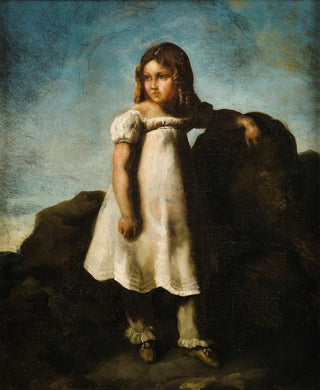Art print | Élisabeth Dedreux Child in the Countryside - Théodore Géricault


View from behind

Frame (optional)
The Reproduction Elisabeth Dedreux child in the countryside - Théodore Géricault – Captivating Introduction
In the vast panorama of art history, certain works manage to capture the very essence of childhood and nature with such intensity that they become silent witnesses of their era. "Elisabeth Dedreux child in the countryside" by Théodore Géricault is one of these works. Created in the early 19th century, this painting evokes not only the delicacy of childhood but also a deep connection with rural life. The child's gaze, filled with innocence and curiosity, transports us to a universe where nature and innocence meet. Géricault, known for his dynamic compositions and mastery of movement, here manages to create a peaceful atmosphere, where every detail seems to tell a story.
Style and uniqueness of the work
The work stands out for its style that is both realistic and romantic, a duality that characterizes Géricault's work. The soft light bathing the scene, as well as the chosen color palette, evoke serenity and warmth that envelop the viewer. The delicate features of Elisabeth's face, along with her pensive expression, testify to a meticulous attention to human emotions. The composition, though simple, is rich in symbolism. The child, surrounded by nature, embodies an idealized vision of childhood, where freedom and the beauty of the natural world intertwine. Géricault, capturing this fleeting moment, invites us to reflect on the purity and simplicity of existence, far from the tumult of adult life.
The artist and his influence
Théodore Géricault, an emblematic figure of the Romantic movement, left an indelible mark on art history. His work, often focused on themes of passion, suffering, and heroism, paved the way for many artists who followed. Géricault, through his innovative approach and commitment to authentic representation of the human condition, inspired generations of artists. His interest in realism and exploration of human emotions contributed to shaping the artistic landscape of his time. "Elisabeth Dedreux"

Matte finish

View from behind

Frame (optional)
The Reproduction Elisabeth Dedreux child in the countryside - Théodore Géricault – Captivating Introduction
In the vast panorama of art history, certain works manage to capture the very essence of childhood and nature with such intensity that they become silent witnesses of their era. "Elisabeth Dedreux child in the countryside" by Théodore Géricault is one of these works. Created in the early 19th century, this painting evokes not only the delicacy of childhood but also a deep connection with rural life. The child's gaze, filled with innocence and curiosity, transports us to a universe where nature and innocence meet. Géricault, known for his dynamic compositions and mastery of movement, here manages to create a peaceful atmosphere, where every detail seems to tell a story.
Style and uniqueness of the work
The work stands out for its style that is both realistic and romantic, a duality that characterizes Géricault's work. The soft light bathing the scene, as well as the chosen color palette, evoke serenity and warmth that envelop the viewer. The delicate features of Elisabeth's face, along with her pensive expression, testify to a meticulous attention to human emotions. The composition, though simple, is rich in symbolism. The child, surrounded by nature, embodies an idealized vision of childhood, where freedom and the beauty of the natural world intertwine. Géricault, capturing this fleeting moment, invites us to reflect on the purity and simplicity of existence, far from the tumult of adult life.
The artist and his influence
Théodore Géricault, an emblematic figure of the Romantic movement, left an indelible mark on art history. His work, often focused on themes of passion, suffering, and heroism, paved the way for many artists who followed. Géricault, through his innovative approach and commitment to authentic representation of the human condition, inspired generations of artists. His interest in realism and exploration of human emotions contributed to shaping the artistic landscape of his time. "Elisabeth Dedreux"






